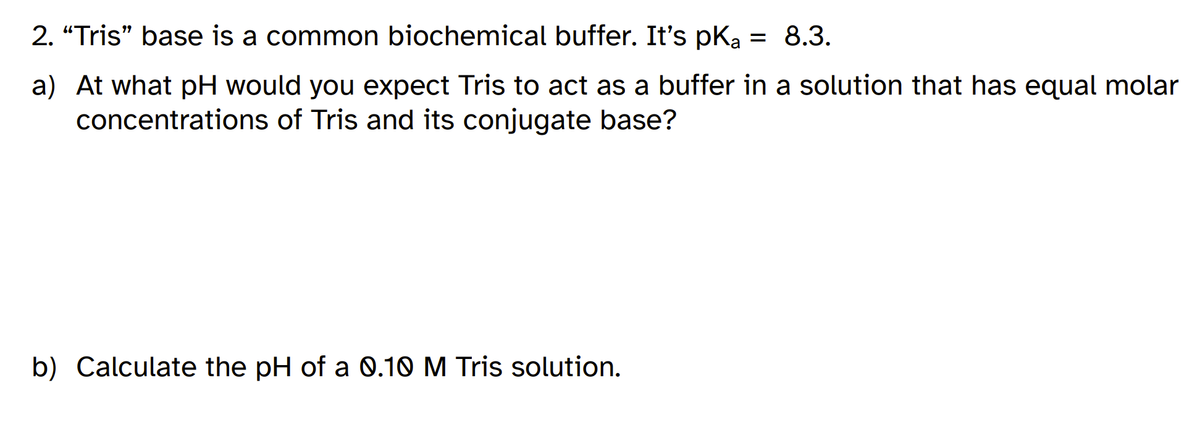1. One of the big differences between "P-chem" standard state and "Biochem" standard state is the pH. The other (somewhat smaller) differences are temperature and pressure. PH Temperature Pressure P-chem 0 ([H+] = 1) 25°C 1 bar Biochem 7 37°C 1 atm Calculate the difference in the equilibrium constant and Gibb's energy for the hydrolysis of 1,3-biphosphoglycerate (1,3-BPG) assuming (a) "P-chem" standard state and (b) "Biochem" standard state. The typical cellular concentrations of the phosphate components of the reaction are given below. 1,3− BPG(aq) + H₂O(1)—3— PG(aq) + HPO²¯ (aq) + H+ (aq) 0.001mM 0.12 mM 1mM
1. One of the big differences between "P-chem" standard state and "Biochem" standard state is the pH. The other (somewhat smaller) differences are temperature and pressure. PH Temperature Pressure P-chem 0 ([H+] = 1) 25°C 1 bar Biochem 7 37°C 1 atm Calculate the difference in the equilibrium constant and Gibb's energy for the hydrolysis of 1,3-biphosphoglycerate (1,3-BPG) assuming (a) "P-chem" standard state and (b) "Biochem" standard state. The typical cellular concentrations of the phosphate components of the reaction are given below. 1,3− BPG(aq) + H₂O(1)—3— PG(aq) + HPO²¯ (aq) + H+ (aq) 0.001mM 0.12 mM 1mM
Chemistry
10th Edition
ISBN:9781305957404
Author:Steven S. Zumdahl, Susan A. Zumdahl, Donald J. DeCoste
Publisher:Steven S. Zumdahl, Susan A. Zumdahl, Donald J. DeCoste
Chapter1: Chemical Foundations
Section: Chapter Questions
Problem 1RQ: Define and explain the differences between the following terms. a. law and theory b. theory and...
Related questions
Question
c) What volume of 1M HCl needs to be added to 1L of 0.10 M Tris to obtain a final pH of
7.4? Ignore dilution effects.
3. Blood pH must stay within ±0.4 from normal (pH 7.4). To do this a buffer system
involving carbon dioxide (product of respiration) is used. The following two equilibria are
involved:
and
a) What is the approximate range of molar concentrations of hydrogen ions for which
life can be sustained?
b) At pH 7.4 what are the concentrations of the two forms of carbonic acid if the total
concentration is 1 mM? The Ka for the H2CO3/HCO3- buffer pair is 4.3x10-7.
c) How can the body use this as a buffer system? (hint: think about La Chatelier’s
principle)
![Worksheet #16
Proton
CHEM 300
transfer equilibria
1. One of the big differences between “P-chem" standard state and "Biochem" standard
state is the pH. The other (somewhat smaller) differences are temperature and pressure.
P-chem
Biochem
pH
O ([H+] = 1)
7
%3D
Temperature
25°C
37°C
Pressure
1 bar
1 atm
Calculate the difference in the equilibrium constant and Gibb's energy for the hydrolysis
of 1,3-biphosphoglycerate (1,3-BPG) assuming (a) "P-chem" standard state and (b)
"Biochem" standard state. The typical cellular concentrations of the phosphate
components of the reaction are given below.
1,3- ВРG (аq)+ Н,0(1) — 3- PG(аg)+ НРО" (аq)+ н" (ад)
0.001MM
0.12 mM
1mM](/v2/_next/image?url=https%3A%2F%2Fcontent.bartleby.com%2Fqna-images%2Fquestion%2F4348600b-df0a-40eb-b81b-d927ae74e213%2F3eddf70a-fdcf-4bb9-b312-f7a89eddac57%2Fqln0iex_processed.png&w=3840&q=75)
Transcribed Image Text:Worksheet #16
Proton
CHEM 300
transfer equilibria
1. One of the big differences between “P-chem" standard state and "Biochem" standard
state is the pH. The other (somewhat smaller) differences are temperature and pressure.
P-chem
Biochem
pH
O ([H+] = 1)
7
%3D
Temperature
25°C
37°C
Pressure
1 bar
1 atm
Calculate the difference in the equilibrium constant and Gibb's energy for the hydrolysis
of 1,3-biphosphoglycerate (1,3-BPG) assuming (a) "P-chem" standard state and (b)
"Biochem" standard state. The typical cellular concentrations of the phosphate
components of the reaction are given below.
1,3- ВРG (аq)+ Н,0(1) — 3- PG(аg)+ НРО" (аq)+ н" (ад)
0.001MM
0.12 mM
1mM

Transcribed Image Text:2. “Tris" base is a common biochemical buffer. It's pK, = 8.3.
a) At what pH would you expect Tris to act as a buffer in a solution that has equal molar
concentrations of Tris and its conjugate base?
b) Calculate the pH of a 0.10 M Tris solution.
Expert Solution
This question has been solved!
Explore an expertly crafted, step-by-step solution for a thorough understanding of key concepts.
Step by step
Solved in 4 steps

Knowledge Booster
Learn more about
Need a deep-dive on the concept behind this application? Look no further. Learn more about this topic, chemistry and related others by exploring similar questions and additional content below.Recommended textbooks for you

Chemistry
Chemistry
ISBN:
9781305957404
Author:
Steven S. Zumdahl, Susan A. Zumdahl, Donald J. DeCoste
Publisher:
Cengage Learning

Chemistry
Chemistry
ISBN:
9781259911156
Author:
Raymond Chang Dr., Jason Overby Professor
Publisher:
McGraw-Hill Education

Principles of Instrumental Analysis
Chemistry
ISBN:
9781305577213
Author:
Douglas A. Skoog, F. James Holler, Stanley R. Crouch
Publisher:
Cengage Learning

Chemistry
Chemistry
ISBN:
9781305957404
Author:
Steven S. Zumdahl, Susan A. Zumdahl, Donald J. DeCoste
Publisher:
Cengage Learning

Chemistry
Chemistry
ISBN:
9781259911156
Author:
Raymond Chang Dr., Jason Overby Professor
Publisher:
McGraw-Hill Education

Principles of Instrumental Analysis
Chemistry
ISBN:
9781305577213
Author:
Douglas A. Skoog, F. James Holler, Stanley R. Crouch
Publisher:
Cengage Learning

Organic Chemistry
Chemistry
ISBN:
9780078021558
Author:
Janice Gorzynski Smith Dr.
Publisher:
McGraw-Hill Education

Chemistry: Principles and Reactions
Chemistry
ISBN:
9781305079373
Author:
William L. Masterton, Cecile N. Hurley
Publisher:
Cengage Learning

Elementary Principles of Chemical Processes, Bind…
Chemistry
ISBN:
9781118431221
Author:
Richard M. Felder, Ronald W. Rousseau, Lisa G. Bullard
Publisher:
WILEY